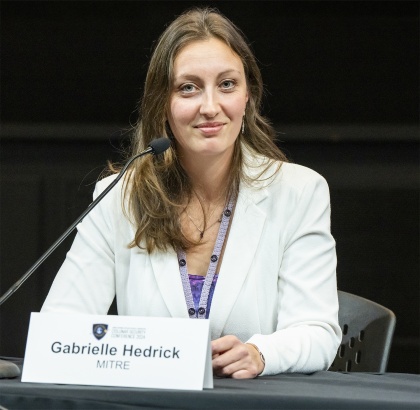Think of aerospace engineer Gabrielle Hedrick, Ph.D., as a living flowchart in the space game—connecting an array of governmental and industry players who all play integral roles in space. Anticipating logistical snags before they occur, Hedrick provides insight that steers future lunar and cislunar missions and their ability to benefit industry, our country, and our world.

Aerospace Engineer Finds MITRE an Atmosphere of Collaboration

Even as a space-obsessed child, Gabrielle Hedrick was scrutinizing systems rather than fantasizing about flight. A case in point: the 2003 Columbia space shuttle disaster.
"I was fascinated that people were going into space—and there were still accidents happening," she recalls. "I remember thinking: 'Why do accidents happen? How could they be prevented? What can we do better?'"
MITRE is uniquely positioned to assess and impact space missions—from government-funded missions to space tourism with private firms—and Hedrick has her work cut out for her. She regularly interfaces with government agencies and private space exploration companies.
What keeps her work energizing, Hedrick says, is MITRE's capability of not only addressing immediate needs in space, but also helping to forecast our sponsors' needs, helping fill in the blanks in domains ranging from health to government relations to AI.
Hedrick, a lead engineer supporting our government sponsors responsible for commercial space operations, "is known for her relentless effort and never-give-up attitude," says Tim Gruber, a MITRE principal systems engineer. "She's a master at navigating roadblocks, leveraging her diverse background, and using logic to lead sponsors to a solution."
Zooming In & Out
Thanks to her background in space, Earth sciences, and management, Hedrick can address both the big picture and the little details in MITRE's work with the space community.
With so many players, Hedrick says, "there are lots of different actors who don't necessarily talk to each other and don't always know what other stakeholders are doing." That's where MITRE comes in: supporting a variety of agencies who have a role in space—even if they don't know it yet.
As an engineer within MITRE's National Security sector, Hedrick helps drive innovation in launch, reentry, and cislunar space by connecting information banks and establishing communication lines. She's working on a range of commercial space endeavors sponsored by the U.S. government. For these projects, Hedrick helps "advance our understanding of industry capabilities and promote the government's ability to face the commercial space demand to safely get assets to space," she explains.
A Whole New World
Similarly, commercial space requires input and cooperation from a wide array of stakeholders. "The commercial space industry isn't necessarily waiting for the government to get up to speed—they're just going to do it," Hedrick says.
The commercial space industry, she says, has introduced the need to look at mission support in new ways.
We are going beyond Earth orbits to the moon and Mars. It’s all happening very quickly—and MITRE is able to meet that pace.
"The launch cadence is growing, and we are going beyond Earth orbits to the moon and Mars," Hedrick notes. "It's all happening very quickly—and MITRE is able to meet that pace, which is a value added for our sponsors."
Last year, Hedrick says, MITRE held a technical exchange meeting, bringing government and industry stakeholders together in the same room to discuss the launch and reentry collision avoidance issue, which is becoming a front-line topic.
"If we are to get humans, astronauts, and passengers alike to space, we need to be able to launch and reenter safely, and we need the ability to send rescue missions quickly," she says.
Finding a Foothold
MITRE's culture of connection was evident even before Hedrick was hired. An aviation department manager had read her qualifications with interest; while they weren't directly correlated to a posted job at the time, Hedrick's background warranted the creation of an entirely new role.
It's a compelling background indeed. Hedrick holds a Ph.D. in aerospace engineering, plus multiple master's degrees in planetary sciences, and in mining and mineral engineering. From deep inside Earth's crust to the outer reaches space, Hedrick has hands-on experience in gold mining, on the Mars Rover Science team, and at NASA's Jet Propulsion Laboratory in robotics engineering.
Even Hedrick's interests outside of her formal education background offer skillsets she's used in her space work at MITRE.
As a volunteer firefighter, ski patroller, and EMT, she brings practical skills in emergency response, medical field care, and hazardous materials—all of which are relevant to human spaceflight and lunar transportation. She also brings her first-responder expertise to bear in other (non-space) areas; for example, supporting the Army in Combat Casualty Care—"a very terrestrial endeavor," as she puts it.
"This is what I love about MITRE – I can use ALL of my expertise across the company," Hedrick says. "At MITRE, we close gaps, break siloes and create awareness among sponsors, as well as build relevant connections across stakeholders."
Join our community of innovators, learners, knowledge-sharers, and risk takers. View our Job Openings and Student Programs. Subscribe to our MITRE 360 Newsletter.